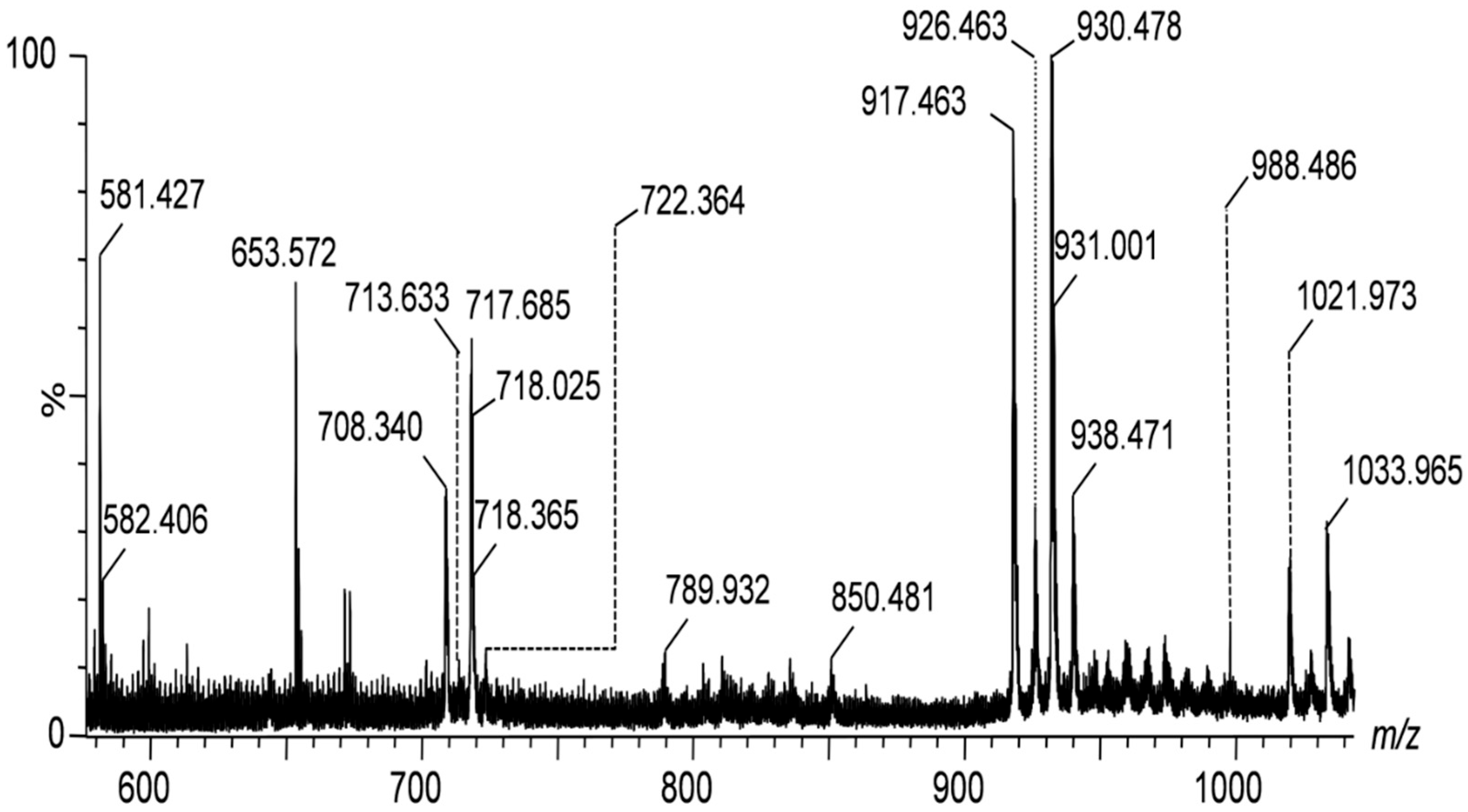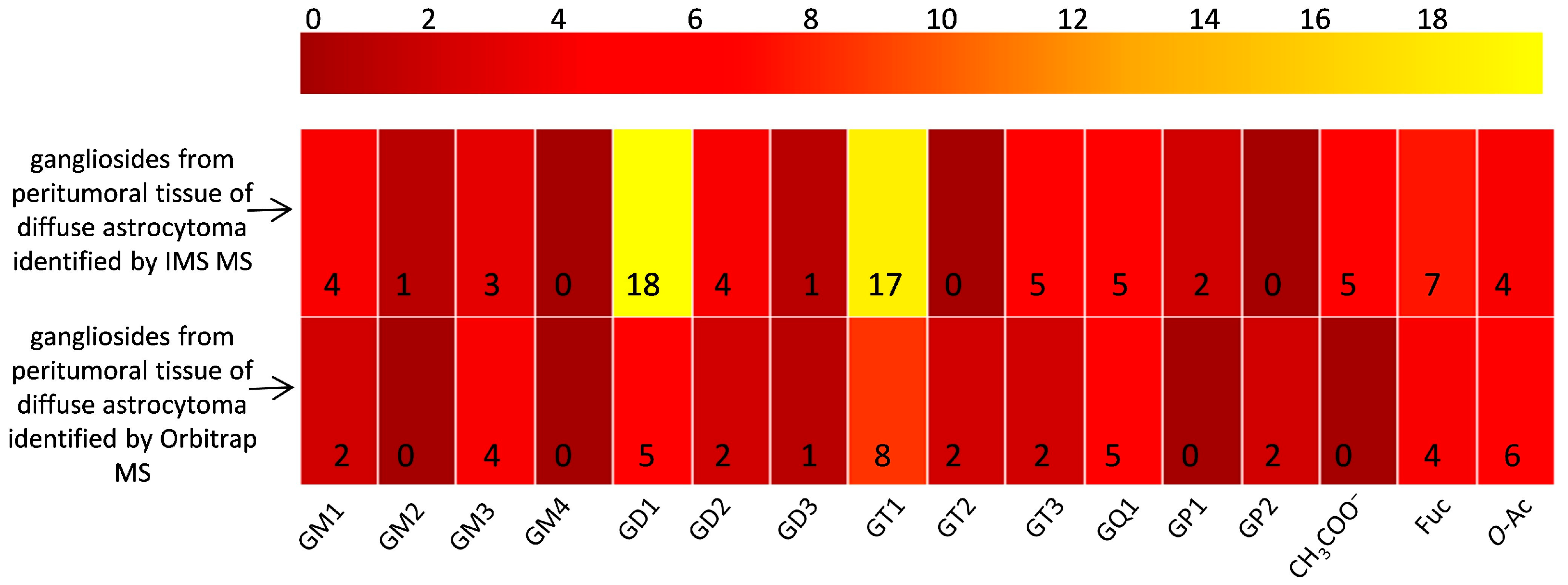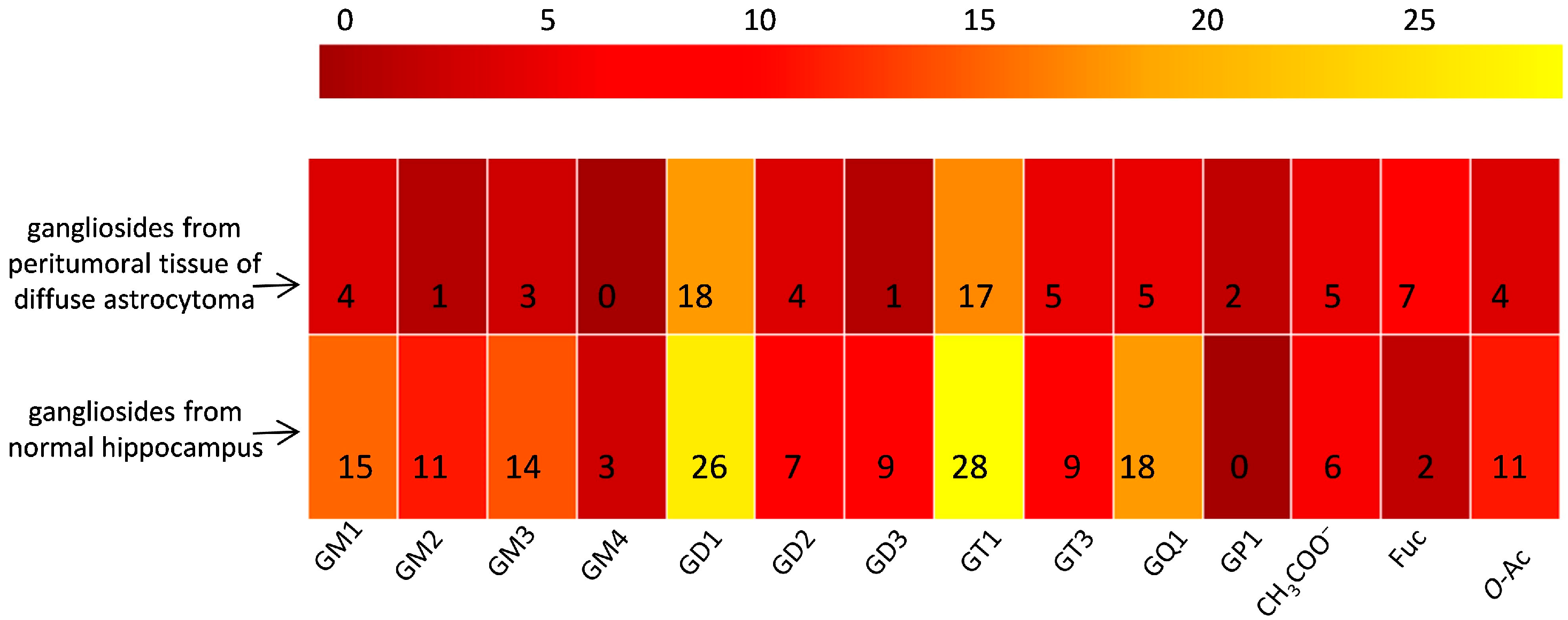Novel Application of Ion Mobility Mass Spectrometry Reveals Complex Ganglioside Landscape in Diffuse Astrocytoma Peritumoral Regions
Abstract
1. Introduction
2. Results and Discussions
3. Materials and Methods
3.1. Peritumoral Tissue
3.2. Extraction and Purification of Gangliosides
3.3. Ion Mobility Mass Spectrometry
3.4. Ganglioside Abbreviation, Nomenclature and Assignment of the Mass Spectra
4. Conclusions
Supplementary Materials
Author Contributions
Funding
Institutional Review Board Statement
Informed Consent Statement
Data Availability Statement
Conflicts of Interest
References
- Lang, M.; Colby, S.; Ashby-Padial, C.; Bapna, M.; Jaimes, C.; Rincon, S.P.; Buch, K. An imaging review of the hippocampus and its common pathologies. J. Neuroimaging 2024, 34, 5–25. [Google Scholar] [CrossRef]
- Madhusoodanan, S.; Ting, M.B.; Farah, T.; Ugur, U. Psychiatric aspects of brain tumors: A review. World J. Psychiatry 2015, 5, 273–285. [Google Scholar] [CrossRef]
- Realmuto, S.; Cinturino, A.; Arnao, V.; Mazzola, M.A.; Cupidi, C.; Aridon, P.; Ragonese, P.; Savettieri, G.; D’Amelio, M. Tumor diagnosis preceding Alzheimer’s disease onset: Is there a link between cancer and Alzheimer’s disease? J. Alzheimers Dis. 2012, 31, 177–182. [Google Scholar] [CrossRef]
- Lanni, C.; Masi, M.; Racchi, M.; Govoni, S. Cancer and Alzheimer’s disease inverse relationship: An age-associated diverging derailment of shared pathways. Mol. Psychiatry 2021, 26, 280–295. [Google Scholar] [CrossRef]
- Xia, S.; Chen, H.; Tang, T. Risk of death from Alzheimer’s disease associated with brain tumor, glioma, and glioblastoma. J. Alzheimers Dis. 2023, 96, 623–631. [Google Scholar] [CrossRef]
- Ahmad, M.H.; Rizvi, M.A.; Ali, M.; Mondal, A.C. Neurobiology of depression in Parkinson’s disease: Insights into epidemiology, molecular mechanisms and treatment strategies. Ageing Res. Rev. 2023, 85, 101840. [Google Scholar] [CrossRef]
- Bondar, L.I.; Osser, B.; Miuța, C.C.; Petran, D.; Baltean, A.I.; Butari, D.B.; Mariș, M.A.; Piroș, L.E.; Almășan, R.; Gavrila-Ardelean, M. Gender-specific insights into depression in patients with ischemic heart disease: Findings from a pilot study using a self-developed questionnaire. Diseases 2024, 12, 320. [Google Scholar] [CrossRef]
- Bondar, L.I.; Iovanovici, D.C.; Măduța, V.; Butari, D.B.; Șandor, F.M.; Mariș, M.A.; Piroș, L.E.; Miuța, C.C.; Toderescu, C.D.; Popescu, M.I. Screening depression in ischemic heart disease: Gender differences and psychosocial implications using a self-developed questionnaire. J. Clin. Med. 2025, 14, 837. [Google Scholar] [CrossRef] [PubMed]
- Battat, M.; Omair, N.; WildAli, M.A.; Alkaissi, A.; Amer, R.; Koni, A.A.; Salameh, H.T.; Zyoud, S.E. Assessment of depression symptoms among cancer patients: A cross-sectional study from a developing country. Sci. Rep. 2024, 14, 11934. [Google Scholar] [CrossRef] [PubMed]
- Starkweather, A.R.; Sherwood, P.; Lyon, D.E.; McCain, N.L.; Bovbjerg, D.H.; Broaddus, W.C. A biobehavioral perspective on depressive symptoms in patients with cerebral astrocytoma. J. Neurosci. Nurs. 2011, 43, 17–28. [Google Scholar] [CrossRef] [PubMed][Green Version]
- Alshoabi, S.A.; Alareqi, A.A.; Omer, A.M.; Suliman, A.G.; Daqqaq, T.S. Diffuse astrocytoma and the diagnostic dilemma of an unusual phenotype: A case report. Radiol. Case Rep. 2020, 16, 319–326. [Google Scholar] [CrossRef]
- Kim, M.M.; Parolia, A.; Dunphy, M.P.; Venneti, S. Non-invasive metabolic imaging of brain tumours in the era of precision medicine. Nat. Rev. Clin. Oncol. 2016, 13, 725–739. [Google Scholar] [CrossRef]
- Tonn, J.C.; Teske, N.; Karschnia, P. Astrocytomas of the spinal cord. Neuro-Oncol. Adv. 2024, 6, 48–56. [Google Scholar] [CrossRef]
- Khandwala, K.; Mubarak, F.; Minhas, K. The many faces of glioblastoma: Pictorial review of atypical imaging features. Neuro-Radiol. J. 2021, 34, 33–41. [Google Scholar] [CrossRef]
- Weller, M.; van den Bent, M.; Hopkins, K.; Tonn, J.C.; Stupp, R.; Falini, A.; Cohen-Jonathan-Moyal, E.; Frappaz, D.; Henriksson, R.; Balana, C.; et al. EANO guideline for the diagnosis and treatment of anaplastic gliomas and glioblastoma. Lancet Oncol. 2014, 15, 395–403. [Google Scholar] [CrossRef]
- Camelo-Piragua, S.; Jansen, M.; Ganguly, A.; Kim, J.C.; Louis, D.N.; Nutt, C.L. Mutant IDH1-specific immunohistochemistry distinguishes diffuse astrocytoma from astrocytosis. Acta Neuropathol. 2010, 119, 509–511. [Google Scholar] [CrossRef] [PubMed]
- Kapoor, M.; Gupta, V. Astrocytoma. In StatPearls; StatPearls Publishing: Treasure Island, FL, USA, 2025. Available online: https://www.ncbi.nlm.nih.gov/books/NBK559042/ (accessed on 8 May 2024).
- Brennan, P.M.; Butler, H.J.; Christie, L.; Hegarty, M.G.; Jenkinson, M.D.; Keerie, C.; Norrie, J.; O’Brien, R.; Palmer, D.S.; Smith, B.R.; et al. Early diagnosis of brain tumours using a novel spectroscopic liquid biopsy. Brain Commun. 2021, 3, fcab056. [Google Scholar] [CrossRef] [PubMed]
- Grishin, A.S.; Achkasova, K.A.; Kukhnina, L.S.; Sharova, V.A.; Ostapyuk, M.V.; Yashin, K.S. Peritumoral brain zone in astro-cytoma: Morphology, molecular aspects, and clinical manifestations (Review). Sovrem. Tekhnologii Med. 2024, 16, 79–88. [Google Scholar] [CrossRef]
- Nejatie, A.; Yee, S.S.; Jeter, A.; Saragovi, H.U. The cancer glycocode as a family of diagnostic biomarkers, exemplified by tu-mor-associated gangliosides. Front. Oncol. 2023, 13, 1261090. [Google Scholar] [CrossRef] [PubMed]
- Mokbel, K. GD2 in breast cancer: A potential biomarker and therapeutic target. Cancer Genom. Proteom. 2024, 21, 549–556. [Google Scholar] [CrossRef]
- Balis, F.M.; Busch, C.M.; Desai, A.V.; Hibbitts, E.; Naranjo, A.; Bagatell, R.; Irwin, M.; Fox, E. The ganglioside GD2 as a circulating tumor biomarker for neuroblastoma. Pediatr. Blood Cancer 2020, 67, e28031. [Google Scholar] [CrossRef]
- Sanni, A.; Bennett, A.I.; Huang, Y.; Gidi, I.; Adeniyi, M.; Nwaiwu, J.; Kang, M.H.; Keyel, M.E.; Gao, C.; Reynolds, C.P.; et al. An Optimized liquid chromatography-mass spectrometry method for ganglioside analysis in cell lines. Cells 2024, 13, 1640. [Google Scholar] [CrossRef] [PubMed]
- Bartish, M.; Del Rincon, S.V.; Rudd, C.E.; Saragovi, H.U. Aiming for the sweet spot: Glyco-immune checkpoints and gammadelta T cells in targeted immunotherapy. Front. Immunol. 2020, 11, 564499. [Google Scholar] [CrossRef] [PubMed]
- Sarbu, M.; Petrica, L.; Clemmer, D.E.; Vukelić, Ž.; Zamfir, A.D. Gangliosides of human glioblastomamultiforme: A compre-hensive mapping and structural analysis by ion mobility tandem mass spectrometry. J. Am. Soc. Mass Spectrom. 2021, 32, 1249–1257. [Google Scholar] [CrossRef]
- Zamfir, A.D.; Fabris, D.; Capitan, F.; Munteanu, C.; Vukelić, Ž.; Flangea, C. Profiling and sequence analysis of gangliosides in human astrocytoma by high-resolution mass spectrometry. Anal. Bioanal. Chem. 2013, 405, 7321–7335. [Google Scholar] [CrossRef] [PubMed]
- Sarbu, M.; Fabris, D.; Vukelić, Ž.; Clemmer, D.E.; Zamfir, A.D. Ion mobility mass spectrometry reveals rare sialylatedglyco-sphingolipid structures in human cerebrospinal fluid. Molecules 2022, 27, 743. [Google Scholar] [CrossRef]
- Biricioiu, M.R.; Sarbu, M.; Ica, R.; Vukelić, Ž.; Kalanj-Bognar, S.; Zamfir, A.D. Advances in mass spectrometry of gangliosides expressed in brain cancers. Int. J. Mol. Sci. 2024, 25, 1335. [Google Scholar] [CrossRef]
- Sarkar, A.; Banerjee, S.; Biswas, K. Multi-dimensional role of gangliosides in modulating cancer hallmarks and their prospects in targeted cancer therapy. Front. Pharmacol. 2023, 14, 1282572. [Google Scholar] [CrossRef]
- Nazha, B.; Inal, C.; Owonikoko, T.K. Disialoganglioside GD2 expression in solid tumors and role as a target for cancer therapy. Front. Oncol. 2020, 10, 1000. [Google Scholar] [CrossRef]
- Cavdarli, S.; Groux-Degroote, S.; Delannoy, P. Gangliosides: The double-edge sword of neuro-ectodermal derived tumors. Biomolecules 2019, 9, 311. [Google Scholar] [CrossRef]
- Groux-Degroote, S.; Delannoy, P. Cancer-associated glycosphingolipids as tumor markers and targets for cancer immuno-therapy. Int. J. Mol. Sci. 2021, 22, 6145. [Google Scholar] [CrossRef]
- Shi, M.; Nan, X.-R.; Liu, B.-Q. The multifaceted role of FUT8 in tumorigenesis: From pathways to potential clinical applications. Int. J. Mol. Sci. 2024, 25, 1068. [Google Scholar] [CrossRef] [PubMed]
- Sarbu, M.; Vukelić, Ž.; Clemmer, D.E.; Zamfir, A.D. Ion mobility mass spectrometry provides novel insights into the expression and structure of gangliosides in the normal adult human hippocampus. Analyst 2018, 143, 5234–5246. [Google Scholar] [CrossRef]
- Liu, J.; Zheng, X.; Pang, X.; Li, L.; Wang, J.; Yang, C.; Du, G. Ganglioside GD3 synthase (GD3S), a novel cancer drug target. Acta Pharm. Sin. B 2018, 8, 713–720. [Google Scholar] [CrossRef]
- Dobie, C.; Skropeta, D. Insights into the role of sialylation in cancer progression and metastasis. Br. J. Cancer. 2021, 124, 76–90. [Google Scholar] [CrossRef]
- Orozco-Moreno, M.; Visser, E.A.; Hodgson, K.; HipgraveEderveen, A.L.; Bastian, K.; Goode, E.A.; Öztürk, Ö.; Pijnenborg, J.F.A.; Eerden, N.; Moons, S.J.; et al. Targeting aberrant sialylation and fucosylation in prostate cancer cells using potent metabolic inhibitors. Glycobiology 2023, 33, 1155–1171. [Google Scholar] [CrossRef]
- Svennerholm, L.; Fredman, P. A procedure for the quantitative isolation of brain gangliosides. Biochim. Biophys. Acta 1980, 617, 97–109. [Google Scholar] [CrossRef]
- Vukelić, Ž.; Metelmann, W.; Muthing, J.; Kos, M.; Peter-Katalinić, J. Anencephaly: Structural characterization of gangliosides in defined brain regions. Biol. Chem. 2001, 382, 259–274. [Google Scholar] [CrossRef]
- Vukelić, Ž.; Kalanj-Bognar, S.; Froesch, M.; Bîndila, L.; Radić, B.; Allen, M.; Peter-Katalinić, J.; Zamfir, A.D. Human gliosar-coma-associated ganglioside composition is complex and distinctive as evidenced by high-performance mass spectrometric determination and structural characterization. Glycobiology 2007, 17, 504–515. [Google Scholar] [CrossRef] [PubMed]
- Schiopu, C.; Flangea, C.; Capitan, F.; Serb, A.; Vukelić, Ž.; Kalanj-Bognar, S.; Sisu, E.; Przybylski, M.; Zamfir, A.D. Determination of ganglioside composition and structure in human brain hemangioma by chip-based nanoelectrospray ionization tandem mass spectrometry. Anal. Bioanal. Chem. 2009, 395, 2465–2477. [Google Scholar] [CrossRef] [PubMed]
- Schiopu, C.; Vukelić, Ž.; Capitan, F.; Kalanj-Bognar, S.; Sisu, E.; Zamfir, A.D. Chip-nanoelectrosprayquadrupole time-of-flight tandem mass spectrometry of meningioma gangliosides: A preliminary study. Electrophoresis 2012, 33, 1778–1786. [Google Scholar] [CrossRef]
- Svennerholm, L. Ganglioside designation. Adv. Exp. Med. Biol. 1980, 125, 11. [Google Scholar]
- Chester, M.A. IUPAC-IUB joint commission on biochemical nomenclature (JCBN). Eur. J. Biochem. 1998, 257, 293–298. [Google Scholar] [PubMed]
- Domon, B.; Costello, C.E. A systematic nomenclature for carbohydrate fragmentations in FAB-MS/MS spectra of glycoconju-gates. Glycoconj. J. 1988, 5, 397–409. [Google Scholar] [CrossRef]
- Costello, C.E.; Juhasz, P.; Perreault, H. New mass spectral approaches to ganglioside structure determinations. Prog. Brain Res. 1994, 101, 45–61. [Google Scholar] [PubMed]
- Ann, Q.; Adams, J. Structure determination of ceramides and neutral glycosphingolipids by collisional activation of [M + Li] + ions. J. Am. Soc. Mass Spectrom. 1992, 3, 260–263. [Google Scholar] [CrossRef]






| No | m/zexp | m/ztheor | Mass Accuracy (ppm) | Proposed Structure * | Molecular Ion |
|---|---|---|---|---|---|
| 1. | 674.863 | 674.870 | 10.39 | GM2(d18:1/16:2) | [M-2H+]2− |
| 2. | 708.340 | 708.346 | 8.47 | GT1(d18:1/18:0)# | [M-3H+]3− |
| 3. | 713.663 | 713.679 | 22.44 | GT1(t18:1/18:0) | [M-3H+]3− |
| 713.6591 | 5.47 | GT1(d18:1/16:0) | [M-5H++2Na]3− | ||
| 4. | 717.685 | 717.692 | 9.76 | GT1(d18:1/20:0)# | [M-3H+]3− |
| 5. | 722.364 | 722.351 | 18.01 | GT1(t18:1/20:1) | [M-3H+]3− |
| 6. | 727.041 | 727.033 | 11.01 | GT1(d18:1/22:0)# | [M-3H+]3− |
| 7. | 735.694 | 735.682 | 15.51 | (CH3COO-) GT1(d18:1/18:0)# | [M-3H++Na+]3− |
| 8. | 770.928 | 770.920 | 10.39 | GM1(d18:1/18:1)# | [M-2H+]2− |
| 9. | 782.906 | 782.919 | 16.62 | GM1(d18:1/18:0)# | [M-3H++Na+]2− |
| 10. | 785.932 | 785.944 | 15.29 | GM1(d18:1/20:0)# | [M-2H+]2− |
| 11. | 789.952 | 789.965 | 16.48 | GD3(d18:1/26:1)# | [M-2H+]2− |
| 12. | 794.012 | 794.018 | 7.56 | GQ1(d18:1/16:3)# | [M-3H+]3− |
| 13. | 822.422 | 822.434 | 14.60 | GD2(d18:1/16:0)# | [M-2H+]2− |
| 14. | 828.444 | 828.452 | 9.66 | GD2(d18:0/18:0) | [M-2H+]2−(-H2O) |
| 15. | 831.397 | 831.392 | 6.02 | GQ1(d18:1/22:0)# | [M-3H+]3− |
| 16. | 850.481 | 850.465 | 18.82 | GD2(d18:1/20:0)# | [M-2H+]2− |
| 17. | 863.462 | 863.474 | 13.90 | GD2(d18:1/22:1) | [M-2H+]2− |
| 18. | 902.122 | 902.110 | 13.30 | GP1(d18:1/18:0)# | [M-3H+]3− |
| 19. | 903.468 | 903.460 | 8.86 | GD1(d18:1/16:0)# | [M-2H+]2− |
| 20. | 916.460 | 916.470 | 10.92 | GD1(d18:1/18:1)# | [M-2H+]2− |
| 21. | 917.463 | 917.475 | 13.09 | GD1(d18:1/18:0)# | [M-2H+]2− |
| 22. | 926.463 | 926.483 | 21.60 | GD1(t18:0/18:0) | [M-2H+]2− |
| 926.453 | 10.80 | GD1(d18:1/18:2) | [M-3H++Na+]2− | ||
| 23. | 930.478 | 930.486 | 8.60 | GD1(d18:1/20:1)# | [M-2H+]2− |
| 24. | 938.471 | 938.483 | 13.75 | GD1(t18:1/20:1) | [M-2H+]2− |
| 938.452 | 19.62 | GD1(d18:1/18:1) | [M-4H++2Na+]2− | ||
| 25. | 950.477 | 950.4839 | 7.26 | O-Ac-GD1(d18:1/20:2)# | [M-2H+]2− |
| 950.4708 | 6.53 | O-Ac-GT3(d18:1/22:1) | [M-4H++2Na]2− | ||
| 26. | 951.493 | 951.488 | 5.26 | O-Ac-GD1(d18:1/20:1) | [M-2H+]2− |
| 27. | 958.468 | 958.476 | 8.35 | (CH3COO−) GD1(d18:1/18:0) | [M−-2H++Na+]2− |
| 28. | 965.478 | 965.484 | 6.22 | (CH3COO−) GD1(d18:1/19:0) | [M−-2H++Na+]2− |
| 29. | 988.486 | 988.4919 | 5.97 | Fuc-GD1(d18:1/18:2) | [M-2H+]2− |
| 30. | 991.508 | 991.512 | 4.04 | Fuc-GT3(d18:1/24:4)# | [M-2H+]2− |
| 991.502 | 6.05 | Fuc-GT3(d18:1/24:3) | [M-2H+]2− | ||
| 31. | 1003.509 | 1003.513 | 3.99 | Fuc-GD1(d18:1/20:1) | [M-2H+]2− |
| 32. | 1009.503 | 1009.512 | 8.92 | (CH3COO−) Fuc-GT3(d18:1/22:2)# | [M−-H+]2− |
| 1009.498 | 4.96 | (CH3COO−) GD1(d18:1/24:2) | [M−-3H++2Na+]2− | ||
| 33. | 1013.486 | 1013.496 | 9.87 | Fuc-GD1(d18:1/20:2) | [M-3H++Na+]2− |
| 34. | 1018.951 | 1018.963 | 11.79 | GT1(d18:1/12:2)# | [M-2H+]2− |
| 35. | 1021.973 | 1021.987 | 13.71 | GT1(d18:0/12:0) | [M-2H+]2− |
| 36. | 1024.523 | 1024.536 | 12.70 | Fuc-GD1(d18:1/23:1)# | [M-2H+]2− |
| 37. | 1027.953 | 1027.969 | 15.58 | GT1(t18:1/12:1)# | [M-2H+]2− |
| 38. | 1029.972 | 1029.954 | 17.49 | GT1(d18:1/12:2) | [M-3H++Na+]2− |
| 39. | 1032.963 | 1032.979 | 15.50 | GT1(d18:1/14:2)# | [M-2H+]2− |
| 40. | 1033.965 | 1033.987 | 21.30 | GT1(d18:1/14:1)# | [M-2H+]2− |
| 41. | 1042.984 | 1042.962 | 21.11 | GT1(d18:1/14:3) | [M-3H++Na+]2− |
| 42. | 1048.996 | 1049.010 | 13.35 | GT1(d18:1/16:0) | [M-2H+]2− |
| 43. | 1062.004 | 1062.018 | 13.18 | GT1(d18:1/18:1)# | [M-2H+]2− |
| 44. | 1063.031 | 1063.026 | 4.42 | GT1(d18:1/18:0)# | [M-2H+]2− |
| 45. | 1074.009 | 1074.017 | 7.45 | GT1(d18:1/20:3)# | [M-2H+]2− |
| 1074.018 | 8.38 | GT1(d18:1/20:0) | [M-2H+]2− | ||
| 46. | 1077.031 | 1077.041 | 9.29 | GT1(d18:1/20:0)# | [M-2H+]2− |
| 47. | 1081.997 | 1082.012 | 13.86 | O-Ac-GT1(d18:1/18:2)# | [M-2H+]2− |
| 48. | 1085.022 | 1085.008 | 12.90 | GT1(d18:1/18:0)# | [M-4H++2Na+]2− |
| 1085.039 | 15.67 | GT1(t18:1/20:0)# | [M-2H+]2− | ||
| 49. | 1088.018 | 1088.030 | 11.03 | GT1(d18:1/20:0) | [M-3H++Na+]2− |
| 50. | 1095.982 | 1095.997 | 13.70 | GT1(d18:1/20:3)# | [M-4H++2Na+]2− |
| 51. | 1099.065 | 1099.054 | 10.01 | GT1(t18:1/22:0) | [M-2H+]2− |
| 52. | 1139.658 | 1139.666 | 7.02 | GM3(t18:1/14:0) | [M-H+]− |
| 53. | 1151.724 | 1151.705 | 16.51 | GM3(d18:1/16:0) | [M-2H+]2− |
| 54. | 1209.769 | 1209.783 | 11.58 | GM3(d18:0/20:0)# | [M-2H+]2− |
| 55. | 1223.583 | 1223.597 | 11.45 | GQ1(d18:0/20:0)# | [M-2H+]2− |
| 56. | 1227.563 | 1227.577 | 11.41 | GQ1 (t18:1/18:0) | [M-3H++Na+]2− |
| 57. | 1310.635 | 1310.642 | 5.42 | Fuc-GQ1(d18:0/22:0) | [M-2H+]2− |
| 58. | 1382.140 | 1382.152 | 8.68 | GP1(d18:0/22:0) | [M-2H+]2− |
| 59. | 1572.873 | 1572.900 | 17.18 | GM1(d18:1/20:0)# | [M-H+]− |
| 60. | 1835.978 | 1835.964 | 7.63 | GD1(d18:1/18:0) | [M-H+]− |
| 61. | 1857.961 | 1857.946 | 8.08 | GD1(d18:1/18:0)# | [M-2H++Na+]− |
| 62. | 1863.974 | 1863.995 | 11.27 | GD1(d18:1/20:0)# | [M-H+]− |
| 63. | 1873.961 | 1873.973 | 6.41 | GD1(d18:0/19:0) | [M-2H++Na+]− |
| 64. | 1879.913 | 1879.923 | 5.32 | GD1(d18:1/18:0) | [M-3H++2Na+] |
Disclaimer/Publisher’s Note: The statements, opinions and data contained in all publications are solely those of the individual author(s) and contributor(s) and not of MDPI and/or the editor(s). MDPI and/or the editor(s) disclaim responsibility for any injury to people or property resulting from any ideas, methods, instructions or products referred to in the content. |
© 2025 by the authors. Licensee MDPI, Basel, Switzerland. This article is an open access article distributed under the terms and conditions of the Creative Commons Attribution (CC BY) license (https://creativecommons.org/licenses/by/4.0/).
Share and Cite
Ica, R.; Sarbu, M.; Biricioiu, R.; Fabris, D.; Vukelić, Ž.; Zamfir, A.D. Novel Application of Ion Mobility Mass Spectrometry Reveals Complex Ganglioside Landscape in Diffuse Astrocytoma Peritumoral Regions. Int. J. Mol. Sci. 2025, 26, 8433. https://doi.org/10.3390/ijms26178433
Ica R, Sarbu M, Biricioiu R, Fabris D, Vukelić Ž, Zamfir AD. Novel Application of Ion Mobility Mass Spectrometry Reveals Complex Ganglioside Landscape in Diffuse Astrocytoma Peritumoral Regions. International Journal of Molecular Sciences. 2025; 26(17):8433. https://doi.org/10.3390/ijms26178433
Chicago/Turabian StyleIca, Raluca, Mirela Sarbu, Roxana Biricioiu, Dragana Fabris, Željka Vukelić, and Alina D. Zamfir. 2025. "Novel Application of Ion Mobility Mass Spectrometry Reveals Complex Ganglioside Landscape in Diffuse Astrocytoma Peritumoral Regions" International Journal of Molecular Sciences 26, no. 17: 8433. https://doi.org/10.3390/ijms26178433
APA StyleIca, R., Sarbu, M., Biricioiu, R., Fabris, D., Vukelić, Ž., & Zamfir, A. D. (2025). Novel Application of Ion Mobility Mass Spectrometry Reveals Complex Ganglioside Landscape in Diffuse Astrocytoma Peritumoral Regions. International Journal of Molecular Sciences, 26(17), 8433. https://doi.org/10.3390/ijms26178433







